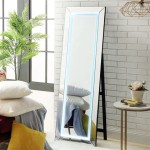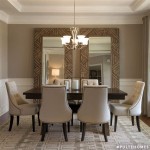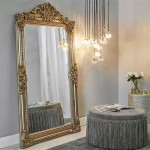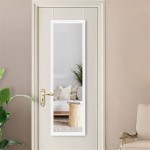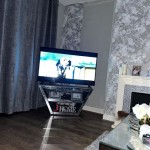How To Hang a Big Mirror On the Wall
Hanging a large mirror can dramatically enhance a room's aesthetics and create an illusion of spaciousness. However, due to their size and weight, large mirrors require careful planning and execution to ensure secure and safe installation. This article provides a comprehensive guide on how to hang a big mirror effectively.
1. Assessing the Mirror and Wall
Before beginning, assess the mirror's weight and dimensions. This information is crucial for selecting appropriate hanging hardware. Similarly, determine the wall type – drywall, plaster, concrete, or brick – as this influences the type of fasteners needed. For exceptionally heavy mirrors, consider consulting a professional for installation.
2. Choosing the Right Hanging Hardware
Selecting the correct hardware is vital for safety and stability. Several options are available, including D-rings, J-hooks, wire, and French cleats. D-rings and J-hooks are suitable for lighter mirrors, while heavy mirrors benefit from the robust support offered by French cleats or heavy-duty wire and picture hangers rated for the mirror's weight. Ensure the hardware’s weight capacity exceeds the mirror's weight.
3. Locating Wall Studs
Locating wall studs provides the most secure anchoring points, especially for heavier mirrors. Use a stud finder to identify stud locations. Mark these locations with a pencil. If hanging the mirror between studs, use appropriate wall anchors rated for the mirror’s weight and the wall type.
4. Marking the Hanging Points
Accurate measurements are critical for proper alignment. Decide on the desired mirror height and mark this on the wall. Measure the distance between the mirror's hanging points (D-rings, wire, or cleat). Transfer these measurements onto the wall, ensuring alignment with the studs or designated anchor points. Use a level to guarantee horizontal accuracy.
5. Installing the Hanging Hardware
If using D-rings or J-hooks, attach them securely to the back of the mirror according to the manufacturer's instructions. Ensure they are evenly spaced and level. For French cleats, one part of the cleat attaches to the wall, while the other attaches to the back of the mirror. If using wire, attach it securely to the D-rings, creating a taut line.
6. Mounting the Mirror on the Wall
Carefully lift the mirror and align the hanging hardware with the marked points on the wall. If using D-rings or J-hooks, hook them onto the screws or nails driven into the studs or anchors. For French cleats, carefully position the cleat attached to the mirror onto the cleat mounted on the wall. Ensure the mirror is flush against the wall and level. For wire, place the wire onto the appropriate hooks or picture hangers.
7. Securing the Mirror (Optional)
For added stability, especially in high-traffic areas or earthquake-prone regions, secure the bottom of the mirror to the wall. Small adhesive bumpers or specialized mirror clips can prevent the mirror from shifting or tipping. These are particularly useful for heavier mirrors.
8. Using the Proper Tools and Safety Measures
Employing the correct tools ensures efficient and safe installation. Essential tools include a stud finder, level, measuring tape, drill (if needed for wall anchors), screwdriver, and appropriate fasteners (screws, nails, or anchors). Prioritize safety by wearing protective eyewear during installation and using a sturdy step stool or ladder for reaching higher points on the wall. If the mirror is extremely heavy, enlist the help of another person to lift and position it safely.
9. Considering Wall Material and Mirror Weight
Different wall materials require different types of fasteners. Drywall might require specific anchors for heavier mirrors. Concrete or brick walls necessitate specialized drill bits and anchors. Always choose fasteners rated for the weight of the mirror and the specific wall material. Consult a hardware professional if unsure about the appropriate anchors or fasteners.
10. Dealing with Uneven Walls
Older homes often have uneven walls. When hanging a large mirror on an uneven wall, shims can be used to create a level surface. Place shims behind the mirror where gaps exist between the mirror and the wall. This ensures proper contact with the wall and prevents the mirror from rocking or appearing tilted.

How To Hang A Large Or Heavy Mirror

How To Hang A Heavy Mirror C R F T

How To Hang A Heavy Mirror

How To Hang A Large Wall Mirror Step By Tutorial

How To Hang A Very Heavy Picture Or Mirror The Best

How To Hang A Heavy Full Length Leaner Mirror On The Wall House Of Hepworths

How To Hang A Heavy Full Length Leaner Mirror On The Wall Hanging Over Door

How To Hang A Heavy Mirror With Pictures Wikihow

How To Hang A Large Wall Mirror Step By Tutorial

How To Hang A Heavy Mirror C R F T

